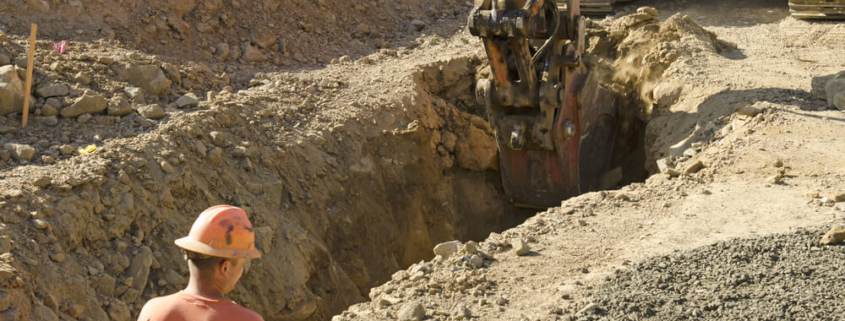5 Things You Should Know to Stay Safe in a Trench
If you work in or around trenches, you have reason to be concerned for your safety. Last year, the Occupational Safety and Health Administration (OSHA) announced that it would enhance oversight and enforcement of safety regulations in response to an “alarming rise” in trenching fatalities. Here’s what you need to know about trench hazards and five things you can do to stay safe in a trench.
What Are Trenches and Excavation on Worksites?
Before getting into how to stay safe in one, what exactly is considered a trench? According to OSHA, a trench is defined as a narrow underground excavation that is deeper than it is wide. Trenches are also no wider than 15 feet.
Excavations are considered to be man-made trenches, cavities, depressions, or cuts in the ground, accomplished by removing earth. Trenches are used for a variety of purposes, including adding utilities to property and building roads or other infrastructure.
Trench Collapses Can Be Serious and Deadly
It’s not surprising that OSHA has made trench safety one of its top priorities. The greatest risk to workers’ lives around trenches revolves around trench collapses and cave-ins. According to OSHA’s latest announcement, 22 workers died in trench collapses in the first half of 2022 alone. This surpassed the 15 fatalities that occurred in all of the prior year.
OSHA has increased inspections on job sites with trenches. It levies fines against employers that don’t adhere to regulations. The agency is also recommending criminal referrals for some trenching-related incidents.
5 Things You Should Know to Stay Safe in a Trench
Construction projects often move dirt around from place to place, and many require the use of trenches. These pose a variety of risks, including cave-ins, water accumulation, falling objects, and damaged underground utilities.
OSHA recommends a combination of safe work practices, protective equipment, and engineering controls to minimize the hazards associated with trenches. Here are five things you should know to stay safe in a trench.
1. Ensure Safe Entry and Exit
Getting in and out of a trench poses its own hazards. And it’s important that workers have a clear way to exit in case of emergencies. All trenches should be cleared of debris, both inside and around the trench. The means of egress must be provided when a trench is at least four feet deep and must not require more than 25 feet of travel.
2. Have Trench Cave-in Protection
Protective systems must be installed in trenches to prevent collapse. OSHA outlines several types, including shoring, benching, and sloping. You may need to use one or several of these systems depending on the size and depth of your trench. In addition, it’s vital that the cave-in protection is installed correctly and remains well-maintained to protect workers from potential hazards.
3. Keep Materials Away from Trench Edges
It’s critical to keep the materials away from the trench edges. Debris and equipment can impede the trench’s ventilation system, creating a hazardous situation for workers. Debris and equipment can also fall into a trench and land on workers. Finally, placing heavy equipment near the edge of a trench can weaken the walls and increase the odds of collapse.
4. Be Aware of Hazards Like Standing Water
Anyone who works around trenches should have proper workplace safety training specific to these hazards. This training should include things like the risk of trench collapse and how to prevent it. Weather conditions can play a large role in trench safety. For example, heavy rain can cause dangerous flooding in a trench or the collapse of walls.
5. Only Enter Trenches After Required Inspections
Conditions on a job site can change overnight or in a matter of just a few hours. According to OSHA, trenches must be inspected daily to prevent minor issues from becoming major problems.
The inspection must take place by a “competent person” who is familiar with proper trench design and safety standards. Once a daily inspection is complete, workers can enter the trench to begin work.
What If You’ve Been Injured in a Trench?
If you’ve been injured in a trench on a construction site or suffered a similar workplace injury, it’s important to understand that your employer has a responsibility to provide a safe and secure workplace that protects you from these types of accidents. Appropriate safety measures and training are part of OSHA guidelines and essential components of workplace preparedness. To learn more about protecting yourself from trench injuries and asserting your rights, contact OSHA Injury Attorney directly.




Leave a Reply
Want to join the discussion?Feel free to contribute!